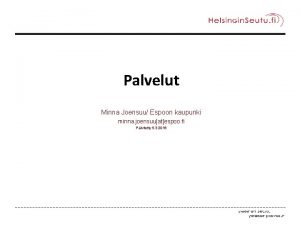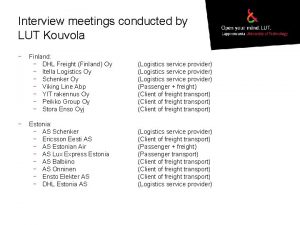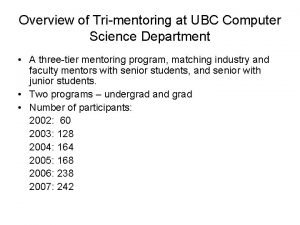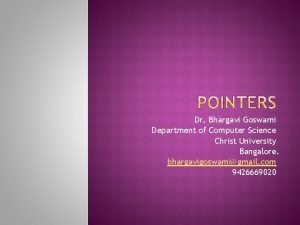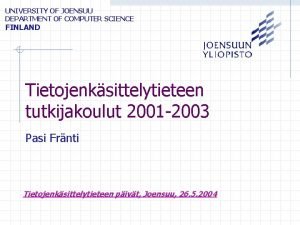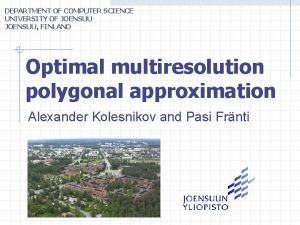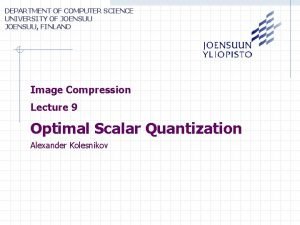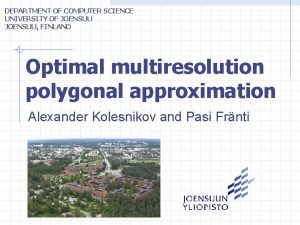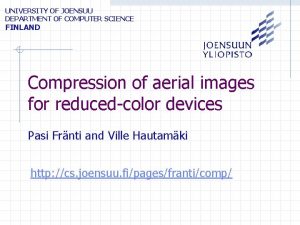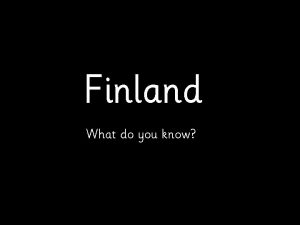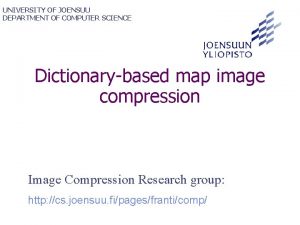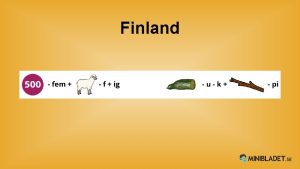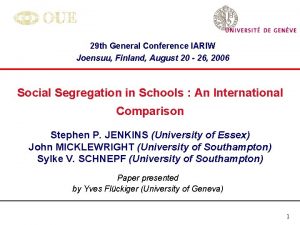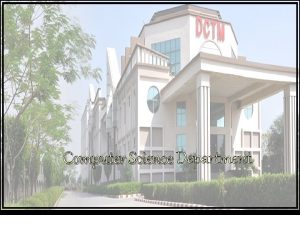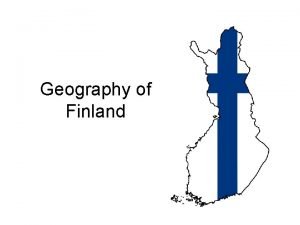UNIVERSITY OF JOENSUU DEPARTMENT OF COMPUTER SCIENCE FINLAND




















- Slides: 20

UNIVERSITY OF JOENSUU DEPARTMENT OF COMPUTER SCIENCE FINLAND Dynamic use of map images in mobile environment Pasi Fränti, Pavel Kopylov and Viktor Veis http: //cs. joensuu. fi/pages/franti/dynamap/

Real-time application Visual view of the surrounding area. GPS or MPS based navigation. Real time panning and zooming.

Map storage vs. Portable device Uncompressed: Electronic library of Finnish Road maps with resolution 1: 250000 takes an entire CD (over 600 Mb). Compressed: The map must be decompressed in the memory, before the image can be viewed. Portable devices: Small storage size 16/64 Mb (up to 512 Mb with Compact. Flash) Weak processor performance: up to 200 Mhz

Properties of maps Maps of 5000 pixels (10 10 km 2). Uncompressed file size 12 Mb. Topographic and Road maps. National Land Survey of Finland: www. nls. fi/index_e. html

Map image storage system (MISS) Zooming: Multi-scale representation. Panning: block decomposition + direct access to compressed file. Compact size: Image compression.

Maps in different scale 1: 80, 000 1: 40 000 (generated from 1: 20 000) 1: 20, 000

Multi-scale organization

Compression method Modelling • Context based statistical modelling Coding • Arithmetic coding

Map image organization Step 1. Map divided into layers Step 2. Layers divided into blocks Step 3. Blocks compressed separately

Decomposition to layers Basic Fields Water Elevation lines Properties

Semantic vs. color separation

Block decomposition 1. Binary layers divided into non-overlapping rectangular blocks 2. Each block compressed separately 3. Compressed blocks are stored in the same file 4. Index table is stored in the header of the file

Use in the client device Current view Movement Update of view

Real-time image decoding

Dynamic use of maps 1. Start with an empty image 2. New blocks downloaded and added only when needed 3. Memory controlled by removing less relevant maps

Update strategies 1. Fully dynamic 1. 2. 3. Everything automatic User has no control Good approach when transmit time is expensive 2. Fully static 1. 2. 3. User initiates requests User controls what/when data are removed Good approach when access to maps is expensive 3. Some compromize between 1 and 2

JBIG compression results File sizes (bytes) Header overheads (%)

The effect of the block size

Decompression times Times are for Set #1 using a processor of 1000 MIPS

Retrieval timings of full screen
 Columbia university department of computer science
Columbia university department of computer science Minna joensuu
Minna joensuu Interview lut
Interview lut Shell moottoriöljy valitsin
Shell moottoriöljy valitsin Joensuu kouvola
Joensuu kouvola Ucl computer science
Ucl computer science Northwestern university computer engineering
Northwestern university computer engineering Computer science department rutgers
Computer science department rutgers Meredith hutchin stanford
Meredith hutchin stanford Florida state university cs faculty
Florida state university cs faculty Trimentoring
Trimentoring Department of computer science christ
Department of computer science christ Nina's favorite subject is science
Nina's favorite subject is science Phoenix online computer science university
Phoenix online computer science university University of bridgeport computer science faculty
University of bridgeport computer science faculty Bridgeport engineering department
Bridgeport engineering department Yonsei syllabus
Yonsei syllabus York university computer science
York university computer science Chapel hill computer science
Chapel hill computer science Seoul national university computer science
Seoul national university computer science Osaka university computer science
Osaka university computer science

